
In this lesson, students will explain the light spectrum and how visible light can be split up as well as describe how spectrophotometer works.
- Material Type:
- Lesson
- Author:
- OER Librarian
- Date Added:
- 09/29/2021

In this lesson, students will explain the light spectrum and how visible light can be split up as well as describe how spectrophotometer works.
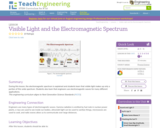
In this lesson, the electromagnetic spectrum is explained and students learn that visible light makes up only a portion of this wide spectrum. Students also learn that engineers use electromagnetic waves for many different applications.
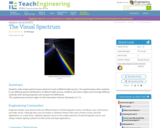
Students make simple spectroscopes (prisms) to look at different light sources. The spectroscopes allow students to see differing spectral distributions of different light sources. Students also shine a light source through different materials with varying properties and compare the differences.
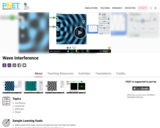
Make waves with a dripping faucet, audio speaker, or laser! Add a second source or a pair of slits to create an interference pattern.
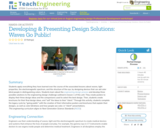
Students apply everything they have learned over the course of the associated lessons about waves, light properties, the electromagnetic spectrum, and the structure of the eye, by designing devices that can aid color blind people in distinguishing colors. Students learn about the engineering design process and develop three possible solutions to the engineering design challenge outlined in lesson 1 of this unit. They create posters to display their three design ideas and the comparisons used to select the best design. Then, students create brochures for their final design ideas, and "sell" the ideas to their "client." Through this activity, students complete the legacy cycle by "going public" with the creation of their informative posters and brochures that explain their designs, as well as color blindness and how people see color, in "client" presentations.
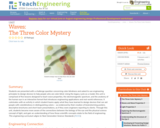
Students are presented with a challenge question concerning color blindness and asked to use engineering principles to design devices to help people who are color blind. Using the legacy cycle as a model, this unit is comprised of five lessons designed to teach wave properties, the electromagnetic spectrum, and the anatomy of the human eye in an interactive format that introduces engineering applications and real-world references. It culminates with an activity in which student teams apply what they have learned to design devices that can aid people with colorblindness in distinguishing colors— as evidenced by their creation of brainstorming posters, descriptive brochures and short team presentations, as if they were engineers reporting to clients. Through this unit, students become more aware of the connections between the biology of the eye and the physical science concept of light, and gain an understanding of how those scientific concepts relate to the field of engineering.

Students learn about the types of waves and how they change direction, as well as basic wave properties such as wavelength, frequency, amplitude and speed. During the presentation of lecture information on wave characteristics and properties, students take notes using a handout. Then they label wave parts on a worksheet diagram and draw their own waves with specified properties (crest, trough and wavelength). They also make observations about the waves they drew to determine which has the highest and the lowest frequency. With this knowledge, students better understand waves and are a step closer to understanding how humans see color.